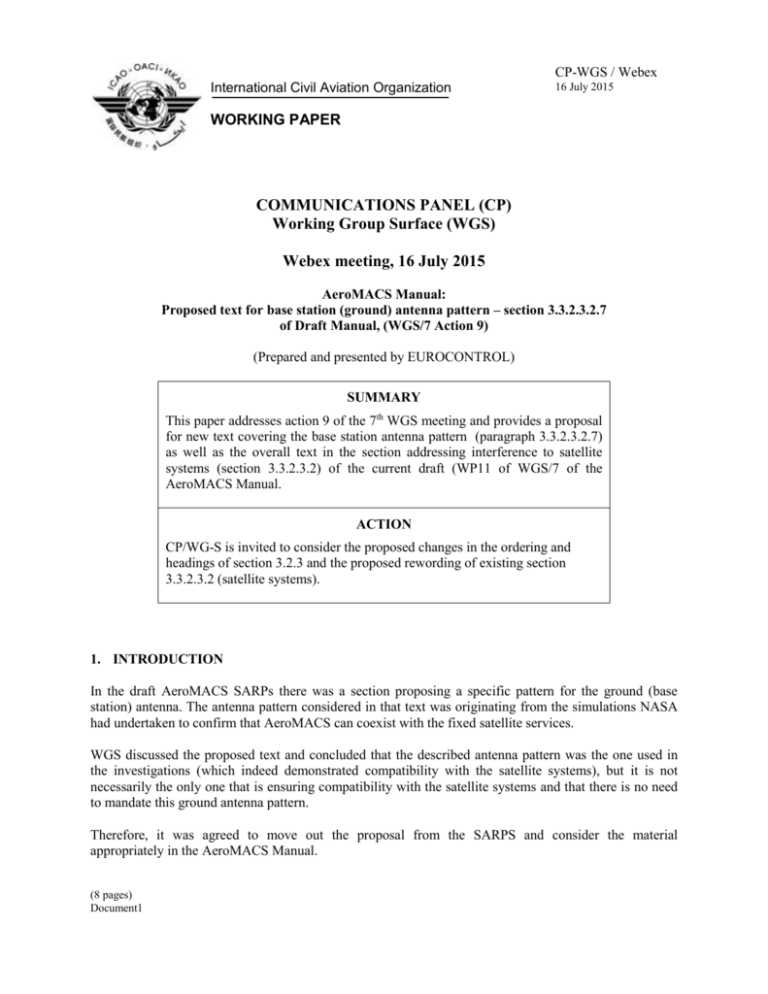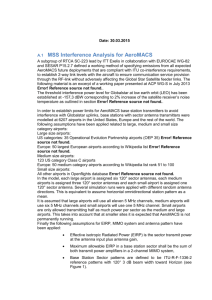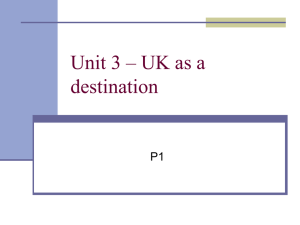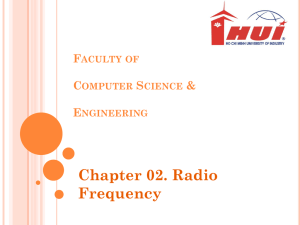WPxx CP WGS_Action 9 from WGS7_v3
advertisement

CP-WGS / Webex International Civil Aviation Organization 16 July 2015 WORKING PAPER COMMUNICATIONS PANEL (CP) Working Group Surface (WGS) Webex meeting, 16 July 2015 AeroMACS Manual: Proposed text for base station (ground) antenna pattern – section 3.3.2.3.2.7 of Draft Manual, (WGS/7 Action 9) (Prepared and presented by EUROCONTROL) SUMMARY This paper addresses action 9 of the 7th WGS meeting and provides a proposal for new text covering the base station antenna pattern (paragraph 3.3.2.3.2.7) as well as the overall text in the section addressing interference to satellite systems (section 3.3.2.3.2) of the current draft (WP11 of WGS/7 of the AeroMACS Manual. ACTION CP/WG-S is invited to consider the proposed changes in the ordering and headings of section 3.2.3 and the proposed rewording of existing section 3.3.2.3.2 (satellite systems). 1. INTRODUCTION In the draft AeroMACS SARPs there was a section proposing a specific pattern for the ground (base station) antenna. The antenna pattern considered in that text was originating from the simulations NASA had undertaken to confirm that AeroMACS can coexist with the fixed satellite services. WGS discussed the proposed text and concluded that the described antenna pattern was the one used in the investigations (which indeed demonstrated compatibility with the satellite systems), but it is not necessarily the only one that is ensuring compatibility with the satellite systems and that there is no need to mandate this ground antenna pattern. Therefore, it was agreed to move out the proposal from the SARPS and consider the material appropriately in the AeroMACS Manual. (8 pages) Document1 CP-WGS Webex / WP-?? -2- This paper addresses this pending action (also captured as action 9 of the 7th WGS meeting) and provides a proposal for new text covering the base station antenna pattern (paragraph 3.3.2.3.2.7) as well as the overall text in the section addressing interference to satellite systems (section 3.3.2.3.2) of the current draft (WP11 of WGS/7 of the AeroMACS Manual. 2. Structure of section 3.3 (Implementation) and ground antenna pattern – Proposal for changes The base station antenna text under discussion is currently in section 3.3.2.3.2 (Satellite Systems), under section 3.3.2.3 (AeroMACS to/from non-avionics system), under section 3.3.2 (Interference minimisation), under section 3.3 (Implementation) under chapter 3. The current (based on WP11 from WGS/7) Table of Contents for section 3.3 is as follows: 3.3 3.3.2 IMPLEMENTATION Interference Minimization 3.3.2.1 Planning Approach 3.3.2.2 Consequences of the Planning Method 3.3.2.3 Sensitivity under mobility conditions 3.3.2.1 Interference to AeroMACS to/from other avionics. 3.3.2.2 Internal AeroMACS Interference 3.3.2.3 AeroMACS to/from non-avionics systems 3.3.2.3.1 Other Systems Occupying the Spectrum 3.3.2.3.2 Satellite SystemsWGS has already discussed that the current numbering of the manual sections needs to be revised and corrected to avoid repetition (i.e. sections 3.3.2.x above) as well as establish a better grouping and flow of the information provided. Overall WGS has agreed that one chapter (in the above numbering it is Chapter 3) will provide explanatory material and information that is considered useful for the implementation of the AeroMACS system and another chapter will cover, in addition to the general requirements in the AeroMACS SARPs, any required/important detailed specifications and recommendations that are proposed to be followed for the correct implementation/deployment of an AeroMACS system. Having reviewed the above structure (Table of Content) of section 3.3, EUROCONTROL is proposing a re-grouping of the existing information as well as changes in the headings of the sections. The proposed changes (strikethrough for deleted and underlined for new text) is provided below: 3.x … 3.x.y IMPLEMENTATION ASPECTS Interference Minimisation /Frequency Compatibility Aspects 3.x.y.1 Frequency planning of AeroMACS services – Guidelines for frequency assignments Group in this new section the following existing sections: 3.3.2.1 Planning Approach 3.3.2.2 Application Consequences of the Planning Method 3.3.2.3 Sensitivity under mobility conditions 3.x.y.2 AeroMACS Interference aspects Group in this new section the following existing sections: 3.3.2.2 Internal AeroMACS Interference 3.3.2.1 Interference to AeroMACS to/from other avionics. -3- CP-WGS Webex / WP?? 3.3.2.3 AeroMACS Interference to/from non-avionics systems 3.3.2.3.1 Other Systems Occupying the Same Spectrum 3.3.2.3.2 Satellite Systems A detailed review needs to be done for the text of the above sections. This paper is next focusing only on the section of the Satellite systems (section 3.3.2.3.2), using as starting point the current (based in WP11 of WGS/7 meeting) complete text of this section which is provided in Appendix 1. ECTL proposes the following text (with revision marks) for the section. Note: The final text for the section below will need to be reviewed in the light of the material in the other sections and possibly a merging of current sections 3.3.2.3.1 and 3.3.2.3.2 should be considered in the next drafting steps. Interference to Satellite Systems The potential of AeroMACS interference to the satellite fixed services transmissions (FSS) has been debated in ITU in WRC20007, as part of the agreement to allow AeroMACS to have an AM(R)S allocation in the 5 GHz band. The agreement in WRC2007, constrains the AeroMACS usage on the airport surface, requiring specific limitations (notably a maximum of a 2% increase in the satellite receiver noise temperature) to be met. Following this agreement, additional studies and investigations have been carried out in US and Europe in particular to demonstrate that AeroMACS meets these requirements. The undertaken analysis considered future dense deployments of AeroMACS in all regions in order to simulate worst case scenarios (which will not be realized in the early deployment of AeroMACS). In addition the analysis considered potential hot spots considering dense simultaneous deployment both in US and Europe. This section summarizes the analysis undertaken in one of the above studies and presents as an example the assumptions and outcome of calculating aggregated emissions from all expected future AeroMACS deployments so that AeroMACS implementations: a) are compliant with the ITU co-interference requirements (WRC2007) and; b) do not adversely affect the Global Star Satellite feeder links. This material is provided in the AeroMACS Manual as guidance and explanatory material to capture some relevant implementation considerations. It is important to note that in WRC2015 some of the limitations agreed in WRC2007 may be reconsidered (i.e. the 2% limit maybe increased to 5%), and in this case additional margin in the implementation considerations will be available. In the WRC2007 discussions the threshold interference power level for Globalstar at low earth orbit (LEO) has been established at -157,3 dBW corresponding to a maximum 2% increase of the satellite receiver’s noise temperature. In order to establish power limits for AeroMACS base station transmitters and to avoid interference with the Globalstar uplinks, the AeroMACS base stations with sector antenna transmitters were modelled at 6207 airports in the United States, Europe and the rest of the world. The following assumptions have been applied related to large, medium and small size category airports: Large size airports: CP-WGS Webex / WP-?? -4- o US categories: 35 Operational Evolution Partnership airports (OEP 35) Error! Reference source not found. o Europe: 50 largest European airports according to Wikipedia list Error! Reference source not found. Medium size airports: o 123 US category Class C airports o Europe: 50 medium category airports according to Wikipedia list rank 51 to 100 Small size airports: o All other airports in Openflights database Error! Reference source not found. <editors note: what do we do with the references? Propose deleting them from above text section and possibly, Also a comment received was that maybe we do not need to provide so much details for this simulation and maybe an alternative would be to reduce the text and provide a reference to the NASA study as well as a to other similar analysis, i.e in SESAR> In the model used in the investigations, each large airport is assigned six 120° sector antennas, each medium airports is assigned three 120° sector antennas and each small airport is assigned one 120° sector antenna. Several simulation runs were applied with different random antenna directions. This is equivalent to assume horizontal omnidirectional station pattern as a mean. The simulations assumed that large airports will use all eleven 5 MHz channels, medium airports will use six 5 MHz channels and small airports will use one 5 MHz channel. Small airports are only allowed transmitting half as much power per sector as the medium and large airports. This takes into account that at smaller sites it is expected that AeroMACS is not permanently running. Finally the following assumptions for EIRP, MIMO system and antenna pattern have been applied: Effective isotropic Radiated Power (EIRP) is the sector transmit power at the antenna input plus antenna gain, Maximum allowable EIRP in a base station sector shall be the sum of both transmit power amplifiers in a 2-channel MIMO system, Base Station Sector patterns are defined to be ITU-R-F-1336-2 reference patterns with 120° 3 dB beam width toward Horizon (see Error! Reference source not found.). NOTE: Two diagrammes showing antenna and mask patterns could not be copied. Based on the simulations, the analysis concluded that under the assumptions considered the AeroMACS deployment will be meeting the ITU WRC2007 requirements , when the worldwide deployment of AeroMACS base stations observe the following emissions limitations: 1) The total base station EIRP in a sector must not exceed: 39.4 dBm for elevation angles up to 1.5 degrees 39.4 dBm linearly decreasing (in dB) to 24.4 dBm for elevation angles from 1.5 to 7.5 degrees 24.4 dBm linearly decreasing (in dB) to 19.4 dBm for elevation angles from 7.5 to 27.5 degrees 19.4 dBm linearly decreasing (in dB) to 11.4 dBm for elevation angles from 27.5 to 90 degrees -5- CP-WGS Webex / WP?? 2) The total mobile station EIRP shall not exceed 30 dBm Note: The above ground antenna elevation pattern is contained in ITU-R F.1336-2. <Consider deleting all yellow highlighted text below> These limitations were derived under the following assumptions: (a) EIRP is defined as antenna gain in a specified elevation direction plus the average AeroMACS transmitter power. While the instantaneous peak power from a given transmitter can exceed that level when all of the subcarriers randomly align in phase, when the large number of transmitters assumed in the analysis is taken into account, average power is the appropriate metric. (b) The breakpoints in the base station EIRP mask are consistent with the elevation pattern of a +15 dBi peak, 120 degree sector antenna as contained in ITU-R F.1336-2. (c) If a station sector contains multiple transmit antennas on the same frequency (e.g., MIMO), the specified power limit is the sum of the power from each antenna. (d) No base station antenna down-tilt is applied in these assumptions. Higher sector average transmit power can meet these limitations if antenna pattern down-tilt is used. (e) Mobile station EIRP is based on full occupancy of transmit sub-carriers for 5 MHz bandwidth The antenna patter identified in the above analysis is one that has been shown via simulations that is meeting the WRC2007 requirements. However it is not specified or recommended to be included in chapter 4 as other patterns may also be suitable. The information in this section aims to raise the awareness of the AeroMACS implementers that in eventual dense (end- state) AeroMACS deployment, the antenna pattern of the (ground) base stations and the antenna tilt need to be carefully considered to avoid impact to FSS systems and to continue meeting any applicable ITU requirement. However, this issue (minimization of impact to FSS) cannot be addressed locally at the level of a single airport or in one region only, as it the global and aggregate interference impact that is important. In order to minimize impact to FSS, it is also important that particularly in case of smaller airports, potentially using a limited number of channels, the choice of the channels is spread among different airports to avoid some channels being over assigned (and over used) while others being under assigned (and under used). Based in the information in this section recommendations are made in Chapter 4, section xxx. Chapter 4, Section xxx As described in section 3.yyyy, the implementation of AeroMACS needs to be planned in a way that it will minimize the risk for potential interference to FSS. In particular the assignments of the channels and the ground antenna patterns and antenna tilt should be considered. CP-WGS Webex / WP-?? -6- In order to spread evenly the interference to FSS, the assignment of AeroMACS channels should be distributed uniformly over areas containing several airports. Note: The above recommendation is particularly relevant for the case of airports not using all AeroMACS channels. It is also recommended that the local AeroMACS implementations (?in conjunction with regional/global bodies????) optimize the ground antenna gain to minimize impact to the FSS services. <editor’s note above recommendation should be further reviewed/reworded> 3. ACTION BY WGS CP/WG-S is invited to consider: 1) the proposed changes in the ordering and headings of section 3.3.2 and 2) the proposed rewording of existing section 3.3.2.3.2 (satellite systems) -7- CP-WGS Webex / WP?? Appendix A: Draft text of section 3.3.2.3.2 of AeroMACS Manual – extract from WP11 of WGS/7 meeting 3.3.2.3.2 Satellite Systems 3.3.2.3.2.1 The following section presents a working method of specifying emissions from all expected AeroMACS future deployments: a) that are compliant with ITU co-interference requirements and; b) do not adversely affect the Global Star Satellite feeder links. 3.3.2.3.2.2 The threshold interference power level for Globalstar at low earth orbit (LEO) has been established at -157,3 dBW corresponding to 2% increase of the satellite receiver’s noise temperature as outlined in section Error! Reference source not found.. 3.3.2.3.2.3 In order to establish power limits for AeroMACS base station transmitters to avoid interference with Globalstar uplinks, base stations with sector antenna transmitters were modelled at 6207 airports in the United States, Europe and the rest of the world. The following assumptions have been applied related to large, medium and small size category airports: Large size airports: o US categories: 35 Operational Evolution Partnership airports (OEP 35) Error! Reference source not found. o Europe: 50 largest European airports according to Wikipedia list Error! Reference source not found. Medium size airports: o 123 US category Class C airports o Europe: 50 medium category airports according to Wikipedia list rank 51 to 100 Small size airports: o All other airports in Openflights database Error! Reference source not found. 3.3.2.3.2.4 In the model, each large airport is assigned six 120° sector antennas, each medium airports is assigned three 120° sector antennas and each small airport is assigned one 120° sector antenna. Several simulation runs were applied with different random antenna directions. This is equivalent to assume horizontal omnidirectional station pattern as a mean. 3.3.2.3.2.5 It is assumed that large airports will use all eleven 5 MHz channels, medium airports will use six 5 MHz channels and small airports will use one 5 MHz channel. Small airports are only allowed transmitting half as much power per sector as the medium and large airports. This takes into account that at smaller sites it is expected that AeroMACS is not permanently running. 3.3.2.3.2.6 Finally the following assumptions for EIRP, MIMO system and antenna pattern have been applied: Effective isotropic Radiated Power (EIRP) is the sector transmit power at the antenna input plus antenna gain, Maximum allowable EIRP in a base station sector shall be the sum of both transmit power amplifiers in a 2-channel MIMO system, CP-WGS Webex / WP-?? -8- Base Station Sector patterns are defined to be ITU-R-F-1336-2 reference patterns with 120° 3 dB beam width toward Horizon (see Error! Reference source not found.). NOTE: Two diagrammes showing antenna and mask patterns could not be copied. 3.3.2.3.2.7 Based on the analysis it is recommended that deployment of AeroMACS base stations observe the following emissions limitations: The total base station EIRP in a sector must not exceed: 39.4 dBm for elevation angles up to 1.5 degrees 39.4 dBm linearly decreasing (in dB) to 24.4 dBm for elevation angles from 1.5 to 7.5 degrees 24.4 dBm linearly decreasing (in dB) to 19.4 dBm for elevation angles from 7.5 to 27.5 degrees 19.4 dBm linearly decreasing (in dB) to 11.4 dBm for elevation angles from 27.5 to 90 degrees In addition the following requirement for the mobile stations is applied: The total mobile station EIRP shall not exceed 30 dBm These limitations include the following assumptions: (b) EIRP is defined as antenna gain in a specified elevation direction plus the average AeroMACS transmitter power. While the instantaneous peak power from a given transmitter can exceed that level when all of the subcarriers randomly align in phase, when the large number of transmitters assumed in the analysis is taken into account, average power is the appropriate metric. (b) The breakpoints in the base station EIRP mask are consistent with the elevation pattern of a +15 dBi peak, 120 degree sector antenna as contained in ITU-R F.1336-2. (c) If a station sector contains multiple transmit antennas on the same frequency (e.g., MIMO), the specified power limit is the sum of the power from each antenna. (d) No base station antenna down-tilt is applied in these assumptions. Higher sector average transmit power can meet these limitations if antenna pattern down-tilt is used. (f) Mobile station EIRP is based on full occupancy of transmit sub-carriers for 5 MHz bandwidth






